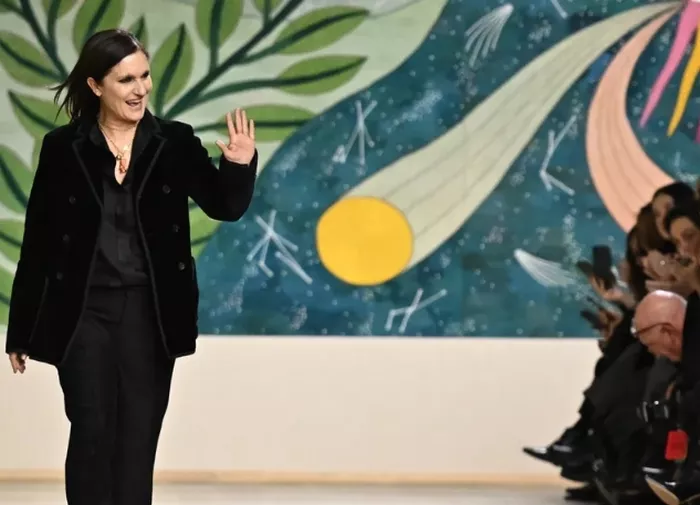Maria Grazia Chiuri took her final bow at Dior’s Cruise 2026 show in Rome on May 27, and the fashion world sensed a shift was coming. Two days later, on May 29, Dior officially confirmed that Chiuri’s time as creative director had come to an end. Her farewell collection, staged dramatically at nightfall in the historic Villa Albani Torlonia, marked the close of a transformative chapter for the French fashion house.
In a statement released by the brand, Chiuri expressed her gratitude for the opportunity. “After nine years, I am leaving Dior, delighted to have been given this extraordinary opportunity,” she said.
Delphine Arnault, chairman of LVMH and CEO of Christian Dior, acknowledged Chiuri’s impact with appreciation, noting, “She has written a key chapter in the history of Christian Dior, greatly contributing to its remarkable growth and being the first woman to lead the creation of women’s collections.” Arnault praised her for bringing an “inspiring feminist perspective and exceptional creativity” to the house.
Chiuri’s path to the top of Dior began with roles in handbag and accessories design at Fendi and Valentino. In 2016, she made history as the first woman to be named creative director of Dior, a house founded in 1947. Her debut ready-to-wear collection redefined Dior’s legacy through a fresh, female-centric lens.
In a 2023 interview with The Guardian, Chiuri reflected on the industry’s gender dynamics. “Everybody was so surprised when I became the first woman in charge,” she said. “What I think is it is very hard for women to arrive in positions of power. The narrative is always that the geniuses are men.”
While Christian Dior’s original vision emphasized the hourglass silhouette with bar jackets and voluminous skirts, Chiuri brought a modern interpretation, driven by the female gaze. Her first collection featured the now-iconic “We Should All Be Feminists” T-shirt, paired with transparent, embroidered skirts—signaling a shift toward empowerment and visibility. Over time, her collections became synonymous with graphic slogan tees, ethereal sheer dresses, and contemporary reinterpretations of Dior’s classic silhouettes.
Though not all of her runway work was universally acclaimed, Chiuri demonstrated a savvy sense for creating pieces that resonated far beyond the fashion shows. Her introduction of the Dior Book Tote in 2018 and the revival of the iconic Saddle Bag contributed to Dior’s revenue skyrocketing to an estimated $9 billion by the time of her departure.
Chiuri was also deeply committed to craftsmanship. She frequently collaborated with local artisans and ateliers for her couture and cruise collections, emphasizing traditional handwork and artistry. She invited female artists to co-create elaborate show settings, with many of these collaborations featured in the documentary Her Dior. She summarized her philosophy in her Guardian interview: “Real feminism is about women supporting each other.”
In her farewell statement, Chiuri expressed heartfelt thanks to Dior’s atelier teams. “Their talent and expertise allowed me to realize my vision of committed women’s fashion, in close dialogue with several generations of female artists,” she said. “Together, we have written an impactful chapter of which I am immensely proud.”
During her tenure, Dior flourished on red carpets around the world. Long-time brand ambassadors like Charlize Theron, Jennifer Lawrence, and Natalie Portman consistently chose Chiuri’s designs for award shows and premieres. Just recently, Lawrence and Portman wore recreations of vintage Dior gowns from the 1950s, part of Chiuri’s final contributions to the house. Rising stars also embraced Dior’s allure—such as Shogun actress Anna Sawai, who wore Dior to her first Met Gala.
Beyond formal events, accessories from the Chiuri era became must-haves for celebrities. Taylor Swift, for example, owns both the Saddle Bag and D-Journey hobo, often seen with them at NFL games and New York outings. Rihanna and Jennifer Lopez also favored Chiuri-era designs, frequently spotted carrying various iterations of the Dior Tote and Lady Dior.
While many designers step down without disclosing their next move, Chiuri has already mapped out her future. According to Vogue, she will return to her native Rome to lead the restoration of Teatro Della Cometa, signaling a continued focus on craft, artistry, and cultural preservation.
Her replacement at Dior has not yet been confirmed, but Vogue reports that Jonathan Anderson, former creative director of Loewe, is poised to take the reins. His potential appointment would reflect an ongoing trend across luxury houses—where female creative leadership remains the exception, not the rule. Despite the increasing recognition of female perspectives in fashion, leadership roles at houses like Balenciaga, Chanel, and Valentino continue to skew male-dominated. Appointments such as Louise Trotter’s at Bottega Veneta remain rare.
This reality only further highlights the significance of Chiuri’s time at Dior. Her legacy not only reshaped the aesthetic of a storied house but also opened doors—and minds—in an industry still reckoning with questions of gender, power, and perspective.
Related Topics
- Tropical Takeover: How FARM Rio Captured the Heart of London’s Fashion Scene
- Slick Chicks Expands Accessibility with Launch of Adaptive Apparel at CVS
- Spring’s Bright Style Notes: Trends Shaping Women’s Fashion This Season

